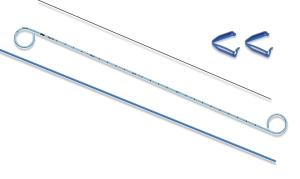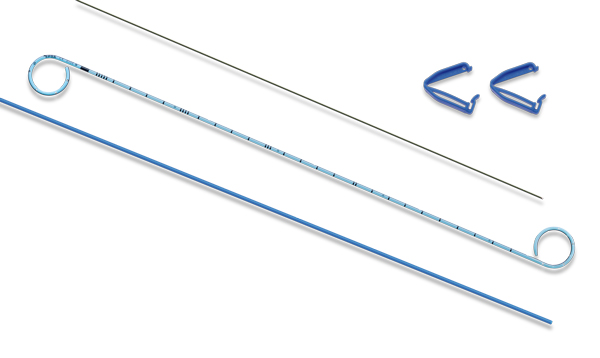DOUBLE “J” URETERAL CATHETER– SET
CODES: 9400 (12 cm)* / 9406 (16 cm)* / 9409 (18 cm)* / 9412 (20 cm)* / 9413 (14 cm)** / 9415 (22 cm)* / 9418 (24 cm)* / 9421 (26 cm)* / 9424 (28 cm)* / 9427 (30 cm)* / 9411 (30 cm)** / 9430 (12cm)** / 9433 (14 cm)** / 9436 (16 cm)** / 9439 (18 cm)** / 9442 (20 cm)** / 9445 (22 cm)** / 9448 (24 cm)** / 9451 (26 cm)** / 9454 (28 cm)**
* closed tip / ** open tip
1 PUR catheter, radiopaque, graduated in cm., coiled cylindrical tips, black longitudinal positioning line, black circumferential mark at the proximal end, open or closed distal catheter end, drainage orifices in its entirety.
1 guide wire made of stainless steel, PTFE coating
1 introducer sheath
2 fixation clamps (for closed tip)
STERILE, SINGLE PACK, SINGLE USE.
Available sizes
Ch 3,0 / 4,8 / 5,0 / 6,0 / 7,0 / 8,0 / 9,0.
Length: 12 / 14 / 16 / 18 / 20 / 22 / 24 / 26 / 28 / 30 cm
Recomen-
daciones
de uso
 Recommendation of a professional on the use of the technology.
Recommendation of a professional on the use of the technology.
The Double “J” Ureteral Drainage – Set is indicated in congenital or acquired, intrinsic or extrinsic pathological processes that compromise normal urinary flow through the ureter.
Of them we highlight:
* Ureteral urinary obstruction:
– Intraluminal:
. urinary stones: stones and grit:
. clots;
. foreign bodies: broken or migrated catheters;
– Parietal:
. tumors of the ureter;
– Extrinsic:
. compression by neighborhood tumors;
. compression due to tumor lymphadenopathy;
. retroperitoneal fibrosis.
* Uretero-pelvic junction obstruction
– Congenital (hydronephrosis) or acquired.
* Obstruction of the uretero-bladder junction
– Congenital (uretero-hydronephrosis) or acquired.
* Trauma and injuries
* Surgical junction areas (neo-anastomosis)
– Reimplants of the ureter in the bladder and intestine
– Urinary fistulas
* Reflux vesicoureteral
* Ureteral loops and kinks
* Prevention of strictures and fistulas
* Alteration of ureteral dynamics
* Intraoperative ureteral identification

